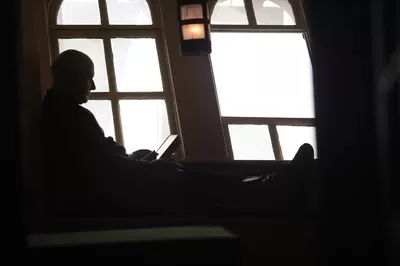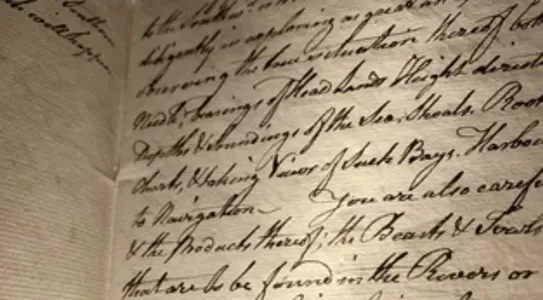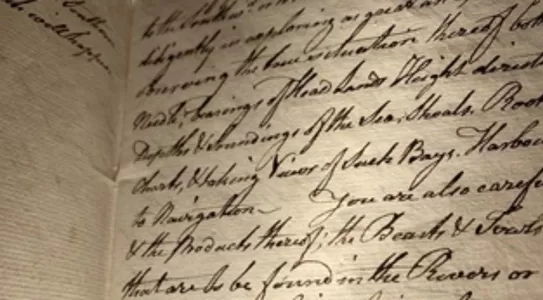Here is the transcript of the Orders, classified Secret, given to Lt. James Cook of the HMB Endeavour, only to be opened on completion of his mission to Tahiti to observe the transit of Venus across the sun in 1768:
Secret
By the Commissioners for executing the office of Lord High Admiral of Great Britain & ca.
Additional Instructions for Lt James Cook, Appointed to Command His Majesty’s Bark the Endeavour
Whereas the making Discoverys of Countries hitherto unknown, and the Attaining a Knowledge of distant Parts which though formerly discover’d have yet been but imperfectly explored, will redound greatly to the Honour of this Nation as a Maritime Power, as well as to the Dignity of the Crown of Great Britain, and may tend greatly to the advancement of the Trade and Navigation thereof; and Whereas there is reason to imagine that a Continent or Land of great extent, may be found to the Southward of the Tract lately made by Captn Wallis in His Majesty’s Ship the Dolphin (of which you will herewith receive a Copy) or of the Tract of any former Navigators in Pursuit of the like kind, You are therefore in Pursuance of His Majesty’s Pleasure hereby requir’d and directed to put to Sea with the Bark you Command so soon as the Observation of the Transit of the Planet Venus shall be finished and observe the following Instructions. You are to proceed to the Southward in order to make discovery of the Continent abovementioned until’ you arrive in the Latitude of 40°, unless you sooner fall in with it. But not having discover’d it or any Evident sign of it in that Run you are to proceed in search of it to the Westward between the Latitude beforementioned and the Latitude of 35° until’ you discover it, or fall in with the Eastern side of the Land discover’d by Tasman and now called New Zeland.
If you discover the Continent abovementioned either in your Run to the Southward or to the Westward as above directed, You are to employ yourself diligently in exploring as great an Extent of the Coast as you can carefully observing the true situation thereof both in Latitude and Longitude, the Variation of the Needle; bearings of Head Lands Height direction and Course of the Tides and Currents, Depths and Soundings of the Sea, Shoals, Rocks & ca and also surveying and making Charts, and taking Views of Such Bays, Harbours and Parts of the Coasts as may be useful to Navigation. You are also carefully to observe the Nature of the Soil, and the Products thereof; the Beasts and Fowls that inhabit or frequent it, the Fishes that are to be found in the Rivers or upon the Coast and in what Plenty and in Case you find any Mines, Minerals, or valuable Stones you are to bring home Specimens of each, as also such Specimens of the Seeds of the Trees, Fruits and
[FIRST PAGE ENDS]
and Grains as you may be able to collect, and Transmit them to our Secretary that We may cause proper Examination and Experiments to be made of them. You are likewise to observe the Genius, Temper, Disposition and Number of the Natives, if there be any and endeavour by all proper means to cultivate a Friendship and Alliance with them, making them presents of such Trifles as they may Value inviting them to Traffick, and Shewing them every kind of Civility and Regard; taking Care however not to suffer yourself to be surprized by them, but to be always upon your guard against any Accidents.
You are also with the Consent of the Natives to take Possession of Convenient Situations in the Country in the Name of the King of Great Britain: Or: if you find the Country uninhabited take Possession for his Majesty by setting up Proper Marks and Inscriptions, as first discoverers and possessors.
But if you shall fail of discovering the Continent beforemention’d, you will with upon falling in with New Zeland carefully observe the Latitude and Longitude in which that Land is situated and explore as much of the Coast as the Condition of the Bark, the health of her Crew, and the State of your Provisions will admit of having always great Attention to reserve as much of the latter as will enable you to reach some known Port where you may procure a Sufficiency to carry You to England either round the Cape of Good Hope, or Cape Horn as from Circumstances you may judge the Most Eligible way of returning home.
You will also observe with accuracy the Situation of such Islands as you may discover in the Course of your Voyage that have not hitherto been discover’d by any Europeans and take Possession for His Majesty and make Surveys and Draughts of such of them as may appear to be of Consequence, without Suffering yourself however to be thereby diverted from the Object which you are always to have in View, the Discovery of the Southern Continent so often Mentioned. But for as much as in an undertaking of this nature several Emergencies may Arise not to be foreseen, and therefore not to be particularly to be provided for by Instruction beforehand, you are in all such Cases to proceed, as, upon advice with your Officers you shall judge most advantageous to the Service on which you are employed. You are to send by all proper Conveyance to the Secretary of the Royal Society Copys of the Observations you shall have made of the Transit of Venus; and you are at the same time to send to our Secretary for our information accounts of your Proceedings, and Copys of the Surveys and discoverings you shall have made and upon your Arrival in England you are immediately to repair to this
[SECOND PAGE ENDS]
Office in order to lay before us a full account of your Proceedings in the whole Course of your Voyage; taking care before you leave the Vessel to demand from the Officers and Petty Officers the Log Books and Journals they may have Kept, and to seal them up for our inspection and enjoying them, and the whole Crew, not to divulge where they have been until they shall have Permission so to do.
Given under our hands the 30 of July 1768
Ed Hawke
Piercy Brett
C Spencer
By Command of their Lordships
[SIGNED]
Php Stephens
°°°°
As an Amazon Associate, I earn a small commission from qualifying purchases.




Left: Captain Frank Allica in the Great Cabin of HMB Endeavour. © 2019 Mark Anning photo
Right: Courtesy of Australian National Maritime Museum
Secret Orders for Lieutenant James Cook appointed to command His Majesty’s Bark the Endeavour, 30 July 1768
In 1767, the Royal Society of London petitioned King George III for a ship to travel to the South Seas. Scientists wanted to view the transit of the planet Venus across the sun, due to take place on 3 June 1769.
On 30 July 1768, the Lords of the Admiralty signed James Cook’s instructions for the voyage on the HMB Endeavour. These orders were classified as Secret and contained in the Letterbook carried on the Endeavour.
Cook’s orders were in two parts. The first orders instructed him to sail to Tahiti from where he and his crew were instructed to observe the transit of Venus.
The second orders were sealed, marked SECRET, only to be opened by James Cook and only at the conclusion of the first task in Tahiti.
After Cook and the scientists on board Endeavour observed the transit of Venus in Tahiti, Cook opened his ‘sealed’ orders – which instructed him to search for the Great South Land that was thought to lie in the southern Pacific Ocean.
“You are to proceed to the Southward in order to make discovery of the Continent above-mentioned until you arrive in the latitude of 40°, unless you sooner fall in with it.”
Secret orders given to James Cook in 1768
The Secret Instructions stated that, if the found the Great South Land, Lt. James Cook should chart its coasts, obtain information about its people, cultivate their friendship and alliance, and annex any convenient trading posts in the King’s name.
When Cook was unable to find this land, he continued west to New Zealand, where he charted the north and south islands, taking notes on the people and their way of life.
After Cook circumnavigated New Zealand, and in doing so disproving Abel Tasman’s theory that it formed part of the southern continent, Cook then sailed west, reaching the southern coast of New South Wales on 20 April 1770.
The Endeavour sailed north along the east coast of this continent, landing at Botany Bay (called ‘Kamay’ in the language of the Dharawal nation) on 29 April 1770. He then continued to survey and chart the Australian coast north to the tip of Queensland. Just before sunset on Wednesday 22 August 1770, on Possession Island, Cook declared the coast a British possession, fulfilling his orders.
The Endeavour then sailed westward, becoming the first European to chart the east coast of New Holland, now known as Australia.
The Secret Orders detail the tasks he was expected to carry out; to make observations of the land and rivers, and to collect as many flora and fauna specimens as could be collected.
Most importantly, the instructions state that Cook should ‘with the Consent of the Natives to take possession of Convenient Situations in the Country in the Name of the King of Great Britain’.
‘Volumes have been filled and will continue to be written as we hear more about Cook’s voyage from the dual perspectives of from the ship and the shore.
One thing is certain though, these orders mark a pivotal moment in Australian history, and it is fitting to have them at the museum on loan from the National Library of Australia for the people of Sydney to view in this 250th year.’
Kevin Sumption, Director and CEO of the Australian Maritime Museum said
This important original document was displayed at the Australian National Maritime Museum during the Encounters 2020 program which marked the 250th anniversary of James Cook’s charting of the east coast of Australia in 1770.
The original is held at the National Library of Australia. The Museum of Australian Democracy has further details Secret Instructions to Lieutenant Cook 30 July 1768.
Read Captain Cook’s journal –
1. James Cook aboard His Majesty’s Bark Endeavour first sight of Australia at Point Hicks
2. James Cook journal: 20th – 28th April, 1770 on HMB Endeavour From Pt. Hicks to Kamay Botany Bay







